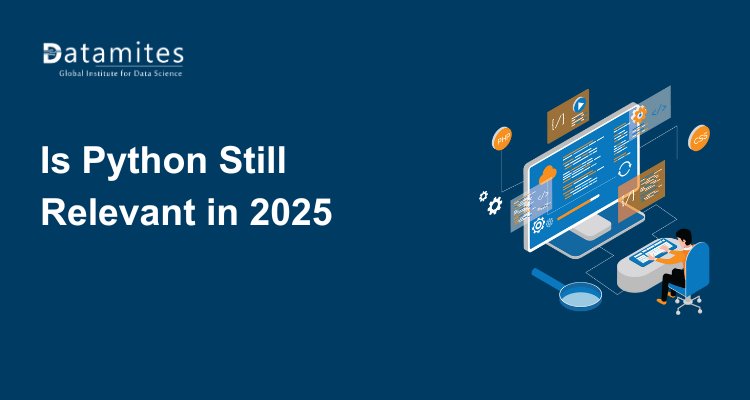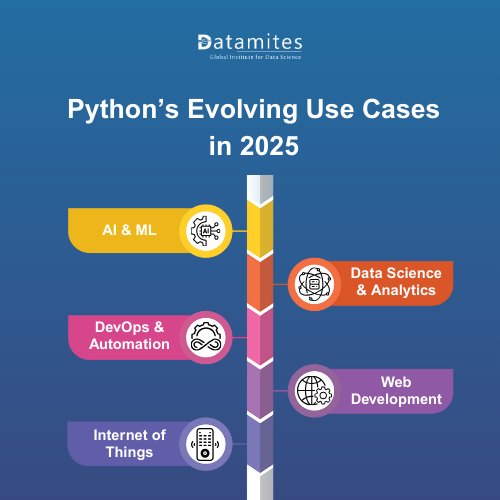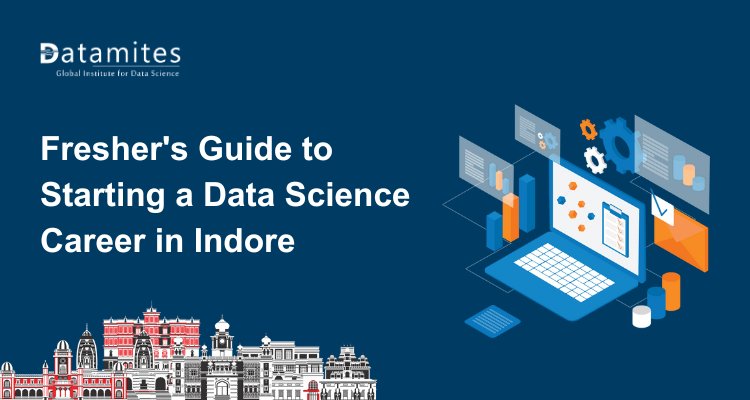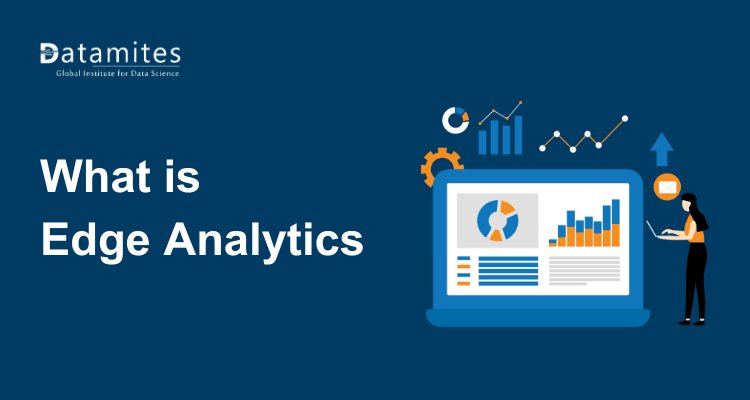Is Python Still Relevant in 2025? Here's What the Trends Say
Is Python still worth learning in 2025? Discover current trends, future prospects, and why Python remains a top language for developers today

In a world where new programming languages emerge quickly, you may be wondering: Is Python still relevant in 2025? With competitors like Rust, Go, and Julia gaining traction, does Python still maintain its lead in the development world?
As new languages rise, Python’s strong community, massive library support, and wide use in machine learning and backend development ensure that it stays crucial in tech. According to Statista, Python was founded more than 30 years ago, which is a long time for any programming language community to mature and evolve to the point where it can support developers at all levels. Despite its age, the Future of Python programming continues to look strong thanks to its adaptability, growing ecosystem, and unmatched versatility.
According to 6Sense, the top three of Python’s competitors in the Programming Languages category are HTML with 61.01%, PHP with 34.66%, and ECMAScript with 1.88% market share.
A Quick Look Back: Why Python Rose to Power
Python didn’t gain its fame overnight. With its clear syntax, ease of use, and comprehensive standard library, Python attracts both novices and experienced developers alike. The language's clear syntax allowed developers to write less code, achieving more, which made it highly approachable.
Frameworks like Django revolutionized web development, while libraries like Pandas and NumPy transformed data analysis by providing easy-to-use, high-performance tools for handling large datasets. When the AI wave hit, Python was already well-positioned with tools like TensorFlow and PyTorch, making it central to machine learning and AI applications.
By 2020, Python became the most popular language globally, and it hasn’t lost momentum. According to the TIOBE Programming Community Index, Python reclaimed the top spot in April 2025, marking its highest-ever position since 2001 and crowning it “Language of the Year” for 2024 due to the largest year‑over‑year gain among all languages. This reflects the power and influence of Python Trends in modern development. Its ability to adapt to new technologies like AI, web development, and automation keeps it at the forefront of Python Trends.
Google adopted Python in 2006, and today, the language powers major platforms like Instagram, Netflix, and Dropbox, reinforcing its influence in shaping Python Trends for the future.
Read More:
- Top 7 Industries Hiring Python Developers in 2025
- Python Fundamentals: Essential Basics for Every Programmer
- Python and Cybersecurity: Beginner Basics for a Secure Future
The 2025 Tech Landscape: What’s Changed?
Technology in 2025 is driven by AI-first development, LLM-powered coding tools, and edge computing, making it an exciting time for both new and established programming languages. Languages like Rust and Go are gaining praise for their speed, performance, and low-level systems capabilities, making them ideal for resource-intensive applications and scalable infrastructures. Despite the rise of these languages, Python remains one of the best programming language for its versatility and wide-ranging applications in fields like AI, data science, and automation.
However, while these newer languages excel in certain niche areas, Python remains the go-to tool for rapid prototyping, scripting, and building AI-driven systems. Its user-friendly nature, rich ecosystem, and broad library support make it crucial for data science, machine learning, and web development. For many developers and organizations, Python continues to be the best programming language for striking a balance between ease of use and powerful capabilities. It may not be the newest car on the lot, but Python is the reliable vehicle that everyone knows how to drive, continuing to power innovations in automation, AI, and enterprise-level applications.
According to Grand View Research, the global application development software market size was valued at USD 257.94 billion in 2024 and is projected to grow at a CAGR of 22.8% from 2025 to 2030.
Indeed lists over 62,000 active Python‑related job postings in the United States alone, spanning roles from backend developers to data analysts.

Python’s Evolving Use Cases in 2025
Python continues to evolve and prove why it remains indispensable in the ever-changing tech landscape. Here’s how Python is staying relevant:
1. AI & Machine Learning
Python drives AI progress through robust libraries like PyTorch 3.0, TensorFlow, and LangChain. Its extensive library ecosystem enables swift creation and deployment of machine learning models. Python’s dominance in AI is reinforced by its scalability and strong developer community, making Python for AI and Machine Learning a top choice for developers worldwide.
2. Data Science & Analytics
Libraries such as Pandas, Seaborn, and Scikit-learn form the backbone of Python’s data analysis capabilities. It's widely used to process, visualize, and interpret complex datasets. Python's smooth integration with big data technologies makes it a top contender for Python for Data Science applications.
According to MarketsandMarkets, the global Data Science Platform Market was valued at $95.3 billion in 2021 and is projected to reach $322.9 billion by 2026, growing at a CAGR of 27.7% during the forecast period
3. Web Development
Frameworks like FastAPI and Django make Python ideal for building web apps. Python supports asynchronous programming, boosting performance in resource-intensive scenarios. Its ease of use and scalability effectively address the needs of contemporary web development, making Python for Web Development a top choice for developers.
4. DevOps & Automation
Python streamlines infrastructure management through automation tools such as Ansible and Fabric. It is integral to CI/CD workflows, simplifying deployment processes and automating system administration duties. Python’s scripting power supports smooth integration across cloud and server environments, making Python for Automation a key asset in modern IT operations.
5. Internet of Things (IoT)
Python’s minimal syntax and adaptable nature make it an ideal fit for Internet of Things (IoT) applications. With MicroPython and Raspberry Pi, developers can build smart devices easily. Its simplicity speeds up prototyping and innovation in embedded systems, making Python for IoT a go-to choice for developers in this field.
Read More:
- Python Developer Salary in India
- Python Programming Career Scope in India
- How much is the Python Course Fee in India
Final Verdict: Is Python Still Relevant in 2025?
As we look ahead, Python’s continued dominance in the tech world is clear. Here’s why it remains a top choice:
- Evolving with modern frameworks and performance tools: New libraries and tools (like PyPy, FastAPI, and Numba) are making Python faster and more efficient.
- Unmatched in AI, automation, and data science: Python is still the leading language for machine learning, deep learning, data analysis, and automation workflows.
- Supported by a massive community and vibrant ecosystem: With over 500,000 packages on PyPI and thriving meetups and conferences, the Python ecosystem keeps growing and adapting.
- Versatile, readable, and flexible: Despite performance limitations, Python remains indispensable for rapid development, especially in AI and scientific computing.
Did you know! The top three geographies of Python for programming-language are the United States with 54,629(50.14%), India with 12,122(11.12%), and the United Kingdom with 9,267(8.50%) customers respectively, according to 6Sense.
How Python Is Adapting
Python isn’t standing still in 2025. Here's how the community is evolving the language and its ecosystem:
- Static Typing: Although Python is dynamically typed, tools like MyPy, Pyright, and type hints have gained significant traction. More Python codebases now use type annotations, making it easier to catch bugs early and work in large teams. This gradual move toward type safety helps Python compete with statically typed languages in professional environments.
- Better Tooling: Python developers today have access to world-class development tools like PyCharm, VS Code (with powerful Python extensions), and JupyterLab. These tools have improved productivity and code quality tremendously, strengthening the Python development experience.
- Interoperability: Python's ability to integrate with C/C++, Java, and JavaScript—through tools like Pyodide and Transcrypt—significantly expands its application scope. PyScript, which allows Python to run in the browser using WebAssembly, is still under active development and has opened the door to new front-end use cases.
- Community Momentum: With consistent leadership from the Python Software Foundation and a highly engaged open-source community, global interest in Python development stays strong through well-attended PyCon conferences, meetups, and hackathons.
Read More:
Why Learn Python in 2025?
If you're considering learning Python this year, here’s why it’s a resounding yes:
- Beginner-friendly syntax: Python's clear, readable code makes it the perfect language for newcomers to programming.
- Rich documentation and learning resources: From free tutorials to comprehensive books and online courses, the wealth of Python learning materials is unparalleled.
- Career potential in AI, automation, and backend development: Python’s dominance in AI, data science, and backend development means job opportunities are abundant, especially in cutting-edge fields.
- Extensive community support: Python’s active community ensures you have access to endless resources, forums, and networking opportunities.
- Versatility across domains: Whether you're interested in web development, machine learning, or automation, Python’s wide range of applications prepares you for various career paths.
In 2025, Python remains not only relevant but strategically essential in many areas of tech — especially in AI, machine learning, automation, and data science. While newer languages bring performance improvements and niche advantages, Python’s simplicity, vast ecosystem, and developer-friendly nature keep it at the forefront of innovation. The language continues to evolve alongside modern demands, with frameworks, tools, and community support adapting to emerging technologies. For those looking to break into these fields, it's a great time to Learn Python.
India’s Python ecosystem is booming, with top cities like Bengaluru, Mumbai, Delhi, Hyderabad, and Pune in high demand for Python professionals in AI, data science, web development, and automation. This has led to a surge in demand for Python Course in Pune and other tech hubs, making it an ideal opportunity to future-proof your career. Mastering Python will give you the hands-on skills that employers across India are actively seeking.
DataMites Institute offers a comprehensive Python Course in Bangalore, aimed at providing students with a strong understanding of Python programming. In addition to Python, the institution also provides specialized training in areas such as Data Science, AI Engineering, Machine Learning, and Data Analytics, with globally recognized certifications. With over 11 years of experience in the industry, DataMites Institute has built a reputation for delivering high-quality education in the tech space.
Serving learners at all skill levels, DataMites Institute has reached more than 100,000 students worldwide, offering courses in key Indian cities like Hyderabad, Pune, Chennai, Mumbai, and Ahmedabad. Whether you are starting from scratch or looking to expand your expertise, DataMites Institute provides training designed to meet the demands of the evolving tech industry.





